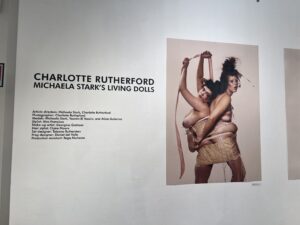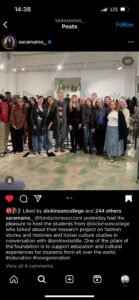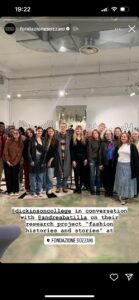Fondazione Sozzani – Andrea Batilla
by Vivian Anderson and Stella Philip
On March 5th, 2024, we visited the Fondazione Sozzani and interviewed Andrea Batilla, one of the most well-known critics in the Italian fashion industry who is currently working as a Brand Strategist. This position is a type of consultant for brands. Brand strategists help brands see where they should go next and how to, in his words, “straighten out their narrative.” We interviewed Batilla in The Fondazione Sozzani, a foundation focused on educating people on 20th and 21st century arts, focusing on fashion and photography. Founded in 1990 by Carla Sozzani, the former fashion editor at the Italian Vogue, the foundation has two locations in Milan and one in Paris. The Fondazione welcomed us in many different ways- Greta Pasini and Simoné Gramegna, the lovely staff, greeted us with open arms, as did the flowering garden that leads up to the entrance of the building itself. This was a comforting greeting after our sweaty walk from our hotel in the heart of Milan. Greta Pasini told us that the foundation aims to promote photographers and designers who create art focused around reclaiming femininity, as evidenced by the current exhibit on display- “The Living Dolls” by Michaela Stark, in collaboration with photogrtapher which we will discuss more later in the blog. Interestingly, the Fondazione never used the word “feminist.”
We soon sat down to prepare for our interview. As we all were getting settled, sitting around a metal table with piles of large fashion books stacked in the center, Andrea Batilla entered in a long gray wool coat, a unique striped sweater and sleek pants. The interview with the educated Batilla extended way beyond the expected end time- 2 hours to be precise. He was funny, witty and insightful. He opened with an address to how the Pope just announced that “gender ideology” is the “worst danger” today. He joked that the Pope must find queer aesthetics ugly, as it is not the Vatican’s kind of aesthetic.
 Andrea Batilla interviewed by Jordan Codispoti at Fondazione Sozzani, in Milan.
Andrea Batilla interviewed by Jordan Codispoti at Fondazione Sozzani, in Milan.
Batilla answered our questions about the “dark side” of the fashion industry, a term he brought up himself. This dark side is the lack of sustainability, the lack of diversity, and the emphasis on profit over art. His point on the lack of diversity particularly interested me, Stella, as a queer woman who looks at everything I research through a queer, feminist lens. He acknowledged the lack of diversity in designers, highlighting the lack of voices, for example, people of color and lesbians.
Another one of his many key points that we, Vivian and Stella, found especially interesting was his perspective on “Made In Italy,” a concept we have been studying in our fashion media studies course Dickinson Wears Prada. To us, before his interview, Made in Italy was about the idea behind the concept, high quality products that allow oneself to live life “the Italian way.” The Italian way was theorized by Baldassar Castiglione during the Renaissance in which aristocrats lived life elegantly without revealing the effort needed to achieve this- also known as sprezzatura. Batilla told us he was currently working on a book about the very topic of Made in Italy. He emphasized that the importance of “made in Italy” as the fact the garments are being created locally and fully within the country. He provided the example of two designers, Marco Rambaldi and Luca Magliano, who live two blocks away from the factory that produces their garments. He described how they can literally be in the factory and ask the seamstresses to make alterations as they go through the process with their workers, allowing for better control over the end product.
Circling back to the Fondazione, once we entered the grand building we were immediately entrenched in the world of Stark’s Living Dolls (pictures below), photographs that featured plus sized models, one of whom being Stark herself, in body-morphing lingerie that emulates historical undergarments with nods to the corsets and girdles. The makeup was reminiscent of the likes of Marie Antoinette, whom we have studied in our fashion history class!





She said it subverts bursary ideals and is a reclamation of feminity. she makes herself the doll. Stark’s lingerie emulated historical undergarments.
In all, this was an amazing day. The next day included an exciting input of our visit being posted by Batilla, the Fondazione, and Sara Sozzani- Carla Sozzani’s sister who took over the foundation after Carla’s passing- who posted on her Instagram page, with 165k followers!




Snapshots of Cara’s Instagram posts of our day at the Fondazione Sozzani.